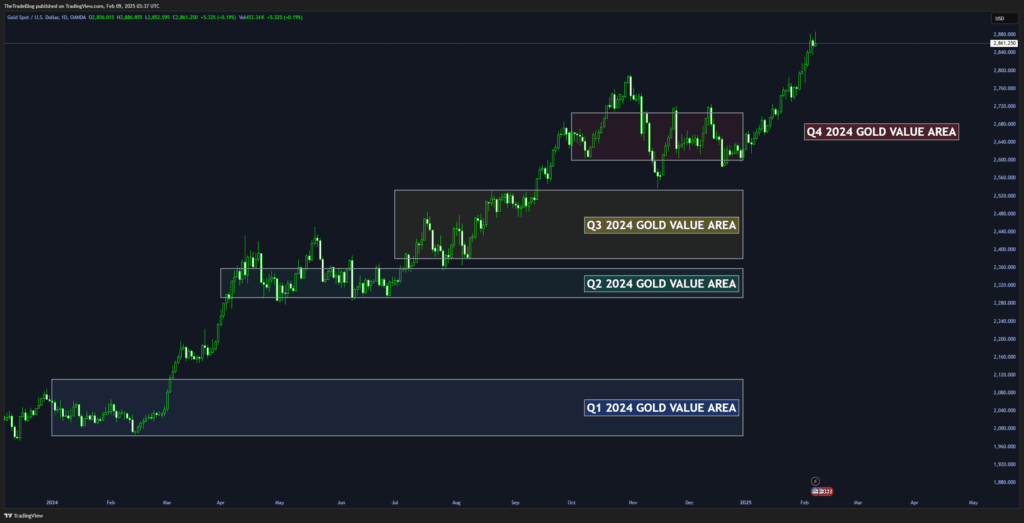Gold prices are surging to new highs as investors seek safety amid global economic uncertainty, rising inflation, and escalating trade tensions. Central banks continue to stockpile gold, pushing demand to record levels, while speculation around a potential U.S. Treasury gold revaluation adds further intrigue. With markets on edge, could this rally signal the beginning of a long-term bull market, or is a pullback on the horizon?
Gold Prices Surge Amid Trade Tensions and Economic Uncertainty
Gold prices are back in the spotlight, surging toward record highs as economic uncertainty fuels demand for safe-haven assets. Spot gold recently climbed to $2,845.14 per ounce, reflecting heightened investor interest amid global market volatility.
This rally comes as concerns grow over trade policies, particularly China’s retaliatory tariffs in response to U.S. trade measures. With investors seeking stability, gold has strengthened its position as a hedge against economic turbulence. According to Reuters, investor sentiment remains bullish as market participants assess the potential impact of these trade tensions on global markets (source: Reuters).
Central Bank Demand Fuels Gold’s Rally
One of the strongest drivers behind gold’s surge is sustained central bank demand. In 2024, global central banks purchased over 1,000 metric tonnes of gold for the third consecutive year, with Poland, India, and Turkey leading acquisitions.
This trend has continued into 2025, reinforcing gold’s upward momentum. Analysts suggest that growing economic uncertainty and a push for financial stability are prompting central banks to diversify their reserves away from traditional fiat currencies, further bolstering gold’s appeal as a safe-haven asset (source: MarketWatch).
| Year | Central Bank Gold Purchases (metric tonnes) |
| 2022 | 1,136 |
| 2023 | 1,037 |
| 2024 | 1,044.6 |
Investment Demand for Gold Hits Four-Year High
Beyond central bank accumulation, investment demand for gold has surged, reaching its highest level in four years. Data shows a 25% increase in investment demand in 2024, pushing total purchases to 1,179.5 metric tonnes. This momentum has carried into early 2025, with gold prices already up 8.5% year-to-date, following a 30% rally in 2024.
Geopolitical tensions, inflation concerns, and market volatility continue to drive investors toward gold as a long-term store of value. Reports indicate a surge in physical gold demand in New York, highlighting a growing preference for tangible assets over paper gold contracts (source: MarketWatch).

Speculation Grows Over Potential U.S. Treasury Gold Revaluation
Adding to the intrigue, recent reports suggest that the U.S. Treasury may be considering a revaluation of its gold reserves to address mounting fiscal challenges. While no official confirmation has been made, analysts speculate that such a move could have profound implications for global markets.
A gold revaluation, if pursued, could significantly alter gold’s price trajectory and reshape the financial landscape in ways not seen since the abandonment of the gold standard. The mere possibility of this shift has fuelled further interest in gold, as investors weigh the potential impact on fiat currencies, inflation, and monetary policy (source: Jerusalem Post).
What’s Next for Gold Prices?
With central banks stockpiling reserves, investors seeking safety, and speculation surrounding U.S. monetary policy, gold’s bullish outlook remains intact. The metal’s resilience amid economic and geopolitical uncertainty suggests that further upside could be on the horizon.
As global markets remain volatile, traders and investors will closely monitor inflation data, central bank actions, and potential policy shifts that could influence gold’s trajectory. Any surprises in monetary policy or shifts in risk sentiment could trigger significant price moves in the coming months.
Final Thoughts
Gold continues to reinforce its status as a safe-haven asset, drawing strength from global instability, fiscal concerns, and shifting investor sentiment. Whether fuelled by central bank accumulation, rising investment flows, or broader macroeconomic shifts, the metal’s rally shows no signs of losing momentum.
With prices hovering near record highs, the next phase will be shaped by central bank policies, inflation trends, and overall risk sentiment. If central banks lower interest rates or inject additional liquidity into the financial system, gold could gain further upside momentum as investors seek protection against currency debasement and declining real yields. Conversely, a stronger U.S. dollar or unexpected monetary tightening could trigger short-term corrections, testing the metal’s resilience.
The question now is not just whether gold can break higher, but how long this rally can be sustained in a rapidly evolving economic landscape. Will gold establish a new price floor, or will external shocks challenge its ascent? The coming months will be pivotal in defining the long-term trajectory of this historic bull run.



